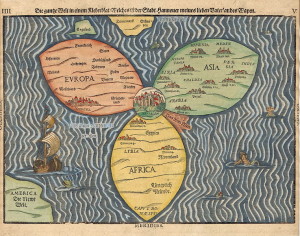By Mary Fairchild
1581 Bunting Clover Leaf Map; Israel in the center.
THE REIGN OF MANASSEH—2 Kings 21: 2 Chron. 33
At the end of the extended 15 years that God gave to Hezekiah, the good king died. In the last words written about him, the Lord chose to mention his might, his goodness, and his famous tunnel that brought water into Jerusalem. The people buried him in the most honorable sepulcher of the sons of David.
MANASSEH, HEZEKIAH’S SON—When Manasseh was just 12 years old he began a co-regency with his father which lasted through the last three years of Hezekiah’s kingship. Manasseh’s 55-year reign (c. 695-642 B.C.) was the longest of any king in Israel or Judah. As a teenager Manasseh rebelled against the Lord. After investigating the cult of Baal and the Babylonian cults, he ultimately dedicated himself to promoting Satan worship through idolatry. He rebuilt the pagan shrines and constructed altars to Baal. He worshiped the stars (astrology) and acted on their influence. He practiced and promoted human sacrifice by offering his own children as sacrifices in the valley of Hinnom. He consulted witches and wizards and condoned fortunetelling.
In the midst of the sudden rejection of the Lord and the return to the ways of his grandfather Ahaz, Manasseh encountered strong opposition from those faithful in Jerusalem. He was unmoved by their opposition and tolerated no allegiance to the God of Israel. The faithful ones were martyred. Jewish history tells us that one of those sawn asunder in Manasseh’s blood bath was the prophet Isaiah. Manasseh led Judah into more sin than was practices by the pagan nations that God had earlier, in Joshua’s day, told His people to destroy. They were more evil than the heathen.
2 Kings 21:9-15; 2 Chron. 33:11—God warned Manasseh and the people, but they did not listen. Manasseh was captured by the Assyrians and was given the typically cruel treatment that captives received in that day.
2 Chron. 33:12-17—The book of Kings does not mention any change in the life of Manasseh, possibly because his repentance came so late that it had little impact on the nation of Judah. However, the chronicler tells us that he Assyrian torture brought Manasseh to his knees before God. Because he repented, the Lord allowed him to return to his throne in Jerusalem. Back in Jerusalem he attempted to reverse the horrible trend toward evil that he had aggressively led. He rebuilt the wall, removed the cults from the Temple and repaired the altar of the Lord, and reestablished the worship of God in the Temple. The people did not wholly follow Manasseh’s reformation; for though they worshiped the Lord, they did it at the pagan shrines, which was not pleasing to the Lord. Manasseh had promoted evil too long. Though we do not know when he was taken captive by the Assyrians nor how long he was held, it appears that his repentance came near the close of his reign. His many years of evil leadership had reversed the trend toward righteousness of Hezekiah’s reign and, therefore, God’s verdict in 2 Kings 21:10-15 would stand.
WORKS CITED
- Revelation and Church History
- Church Age
- Old Testament Study
- KING JAMES BIBLE
- MATTHEW HENRY COMMENTARY
- A Beka Book High School Bible Series “United Kingdom: Kings of Israel A;” 1995 Pensacola Christian College; www.abeka.com

